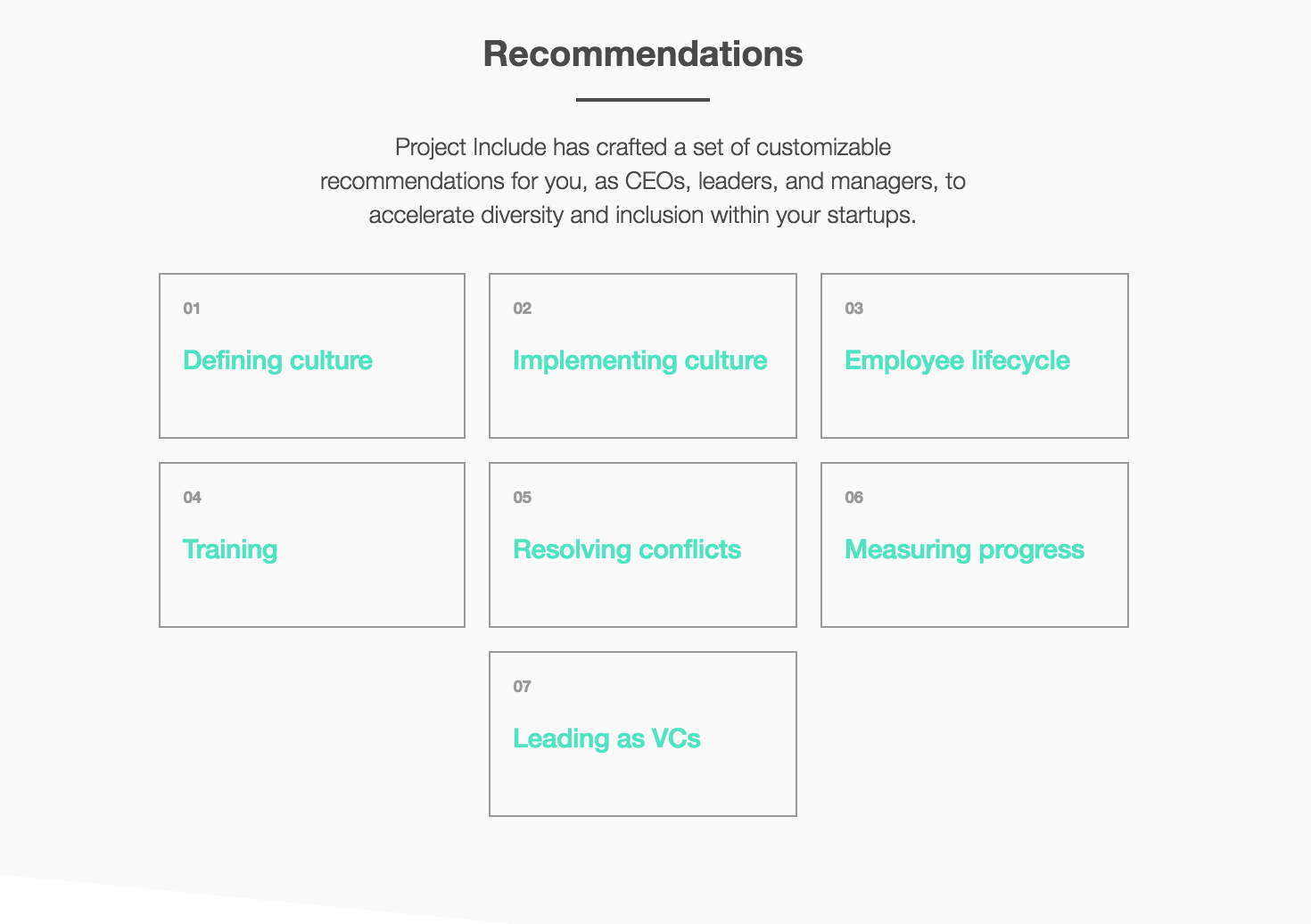A giant war room of diversity advocates in Silicon Valley has formed under the name Project Include. The effort consists of former Reddit interim CEO Ellen Pao, Pinterest engineer Tracy Chou, Kapor Capital Partner Freada Kapor Klein, Slack engineer Erica Baker, ReadySet founder Y-Vonne Hutchinson, angel investor Susan Wu, Cathy Labs CEO bethanye McKinney Blount and Atipica CEO Laura I. Gómez.
“Project Include started as dinner brainstorming sessions on how to make tech meaningfully more diverse,” Pao said in a release. “Today we’ve joined forces to provide CEOs with comprehensive tools–frameworks, research, metrics, and recommendations–for diversity and inclusion. And the early feedback we’ve heard repeatedly from CEOs is, ‘I wish I had had this earlier.’”
Project Include, a non-profit organization, aims to be a resource for people to implement change around diversity and inclusion in the tech industry. The project is focused on small to mid-stage startups, meaning anywhere from 25 to 1,000 employees, according to the New York Times. Project Include’s set of recommendations for CEOs, leaders and managers at startups aim to help them both foster and accelerate diversity and inclusion inside their respective companies. The goal is to get startups to commit to tracking diversity and inclusion, and ultimately share that data with the tech community.

What you see above is the result of a roughly 85-page document on best practices for startups to become more inclusive. If you decide to explore Defining Culture, for example, you’ll see recommendations like “commit to inclusivity in the company culture,” “include transparency in company values and culture” and “define and share clear compensation bands.” Project Include also offers recommendations for VC firms like applying metrics to portfolio reports and valuing the effort it takes to go into diversity and inclusion efforts.
One section that really hits home for me is around measuring progress. The last couple of years have been filled with diversity reports with stats around gender, race, POC and women in leadership positions and technical roles, and so on. In the last few months, we’ve started seeing stats around LGBTQIA populations at companies as well as representation of people with intersectional identities, such as POC and female, or POC and LGBTQIA. But we have yet to see any sort of standard best practices emerge for reporting diversity and inclusion, until now.
“The wrong metrics can present a misleading view of system health, and optimizing against them can produce distorted outcomes,” Project Include states. “There is danger in vanity metrics, which provide good optics but lack significance. For example, some companies include non-engineers in their definitions of their engineering teams, artificially inflating their diversity numbers with groups that are usually more diverse. Internally, this can erode trust with employees who see a lack of diversity on their teams, and can delay identifying and addressing problems, while externally, it can lend a company artificial weight as an industry leader.”
That said, Project Include recommends companies prioritize the following metrics:
- Employees overall, by function, seniority, and tenure, cut by demographics
- Employee status (full-time / part-time / contractor), cut by demographics
- Management and leadership, cut by demographics
- Employees reporting to female managers
- Employees reporting to managers from underrepresented groups
- Salary, cut by demographics
- Raises and bonuses, cut by demographics
- Equity, for all-time and 12 months trailing, cut by demographics
- Employee equity pool, for all-time and 12 months trailing, cut by gender and race
- Investor equity pool, cut by gender and race
- Vesting rates, cut by gender and race
- Board of Directors, cut by demographics
- Candidate pools and hiring funnels, by role, cut by demographics
- Voluntary and involuntary attrition rates, cut by demographics
- Promotion rates, cut by demographics
- Complaints (formal and informal), cut by demographics
- Complaint resolution status
With the following inclusive demographic breakdowns:
- Race/ethnicity, with affordance for multiracial identity
- African-American/Black
- East Asian (including Chinese, Japanese, Korean, Mongolian, Tibetan, and Taiwanese)
- Hispanic/LatinX
- Middle Eastern
- Native American/Alaskan Native/First Nations
- Pacific Islander
- South Asian (including Bangladeshi, Bhutanese, Indian, Nepali, Pakistani, and Sri Lankan)
- Southeast Asian (including Burmese, Cambodian, Filipino, Hmong, Indonesian, Laotian, Malaysian, Mien, Singaporean, Thai, and Vietnamese)
- White
- Prefer not to answer
- Gender
- Sexual orientation
- Family status
- Children in the home part-time or full-time
- Responsibility for the care of other people
- Immigration status
- Veteran status
- English proficiency
- Languages spoken
- Age and tenure at organization
- Educational attainment
- Highest degree
- Highest degree of parents
- College attended: public/private/any
If you want to hear more about Project Include, I’ll be talking to Erica Baker next week at TechCrunch Disrupt NYC.
